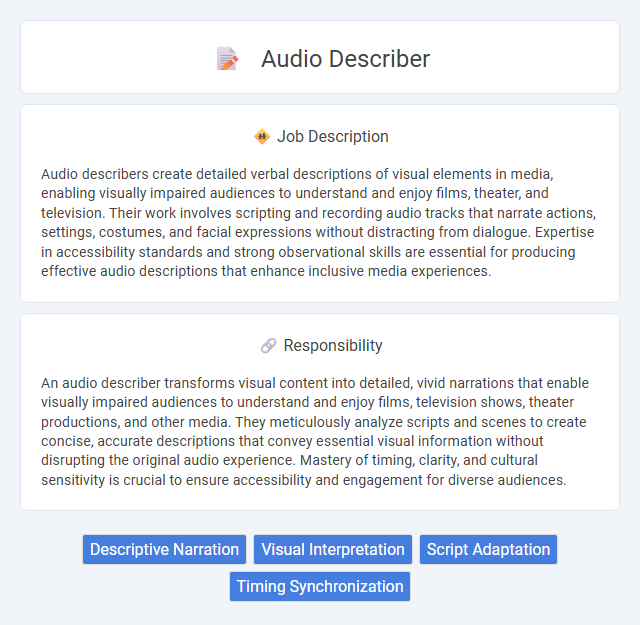
Audio describers create detailed verbal descriptions of visual elements in media, enabling visually impaired audiences to understand and enjoy films, theater, and television. Their work involves scripting and recording audio tracks that narrate actions, settings, costumes, and facial expressions without distracting from dialogue. Expertise in accessibility standards and strong observational skills are essential for producing effective audio descriptions that enhance inclusive media experiences.
People with strong verbal communication skills and a keen attention to detail are likely suitable for an audio describer job, as it requires providing clear, concise narrations of visual content for those with visual impairments. Individuals who are empathetic and patient may find this role rewarding, since it involves understanding the needs of the audience and delivering descriptions that enhance their experience. Those with limited concentration or difficulty articulating descriptions might struggle to perform effectively in this position.
Qualification
Audio describer jobs require strong verbal communication skills and acute attention to detail to translate visual elements into clear, concise audio narration. Candidates typically need experience in scriptwriting or broadcasting, along with a deep understanding of accessibility standards and audience needs. Proficiency in using audio equipment and editing software enhances job performance and ensures high-quality descriptive audio content.
Responsibility
An audio describer transforms visual content into detailed, vivid narrations that enable visually impaired audiences to understand and enjoy films, television shows, theater productions, and other media. They meticulously analyze scripts and scenes to create concise, accurate descriptions that convey essential visual information without disrupting the original audio experience. Mastery of timing, clarity, and cultural sensitivity is crucial to ensure accessibility and engagement for diverse audiences.
Benefit
An audio describer likely enhances accessibility by providing vivid, real-time narration of visual content for individuals with visual impairments. This role probably improves audience engagement and inclusivity, making media experiences more enjoyable and understandable. Employers might benefit from increased compliance with accessibility standards and a broader, more diverse audience reach.
Challenge
The role of an audio describer often involves the challenge of translating visual information into concise, vivid verbal descriptions that enhance accessibility for visually impaired audiences. Balancing accuracy with brevity likely demands strong observational skills and creativity to convey essential details without overwhelming the listener. Consistently maintaining this clarity across diverse content may require adaptability and a deep understanding of both the material and audience needs.
Career Advancement
Audio describers play a critical role in making visual media accessible to visually impaired audiences by providing detailed verbal descriptions of scenes and actions. Career advancement in this field often involves gaining expertise in various media formats, mastering specialized software, and earning certification from professional organizations such as the Audio Description Association or the Described and Captioned Media Program. Opportunities for growth include progressing to senior describer roles, trainer positions, or branching into related areas such as scriptwriting, project management, and accessibility consulting.
Key Terms
Descriptive Narration
An audio describer specializes in creating detailed descriptive narration that enhances accessibility for visually impaired audiences during films, theater performances, and events. This role requires keen observation skills and the ability to convey visual elements like actions, settings, and expressions through clear, concise verbal descriptions. Mastery in timing and language precision ensures the narration complements original audio without overlapping dialogue or sound effects.
Visual Interpretation
Audio describers specialize in translating visual elements of media into detailed, vivid verbal descriptions to make content accessible to visually impaired audiences. They analyze scenes carefully, conveying key visual information such as actions, settings, expressions, and costumes while maintaining narrative flow. Mastery of descriptive language and precise timing ensures the audio description integrates seamlessly with existing dialogue and soundtracks.
Script Adaptation
Audio describers specialize in script adaptation to create vivid, concise descriptions that enhance accessibility for visually impaired audiences. They transform visual elements into clear, engaging narration by interpreting scenes, actions, and settings while maintaining the original tone and pacing. Expertise in media content, vocabulary sensitivity, and timing ensures seamless integration with dialogue and sound effects.
Timing Synchronization
Audio describers ensure precise timing synchronization between narration and visual cues to enhance accessibility for visually impaired audiences. This role requires meticulous coordination to seamlessly integrate descriptive audio with scene changes, dialogue, and important on-screen actions. Mastery of timing tools and software is essential to deliver accurate and engaging audio descriptions.
 kuljobs.com
kuljobs.com